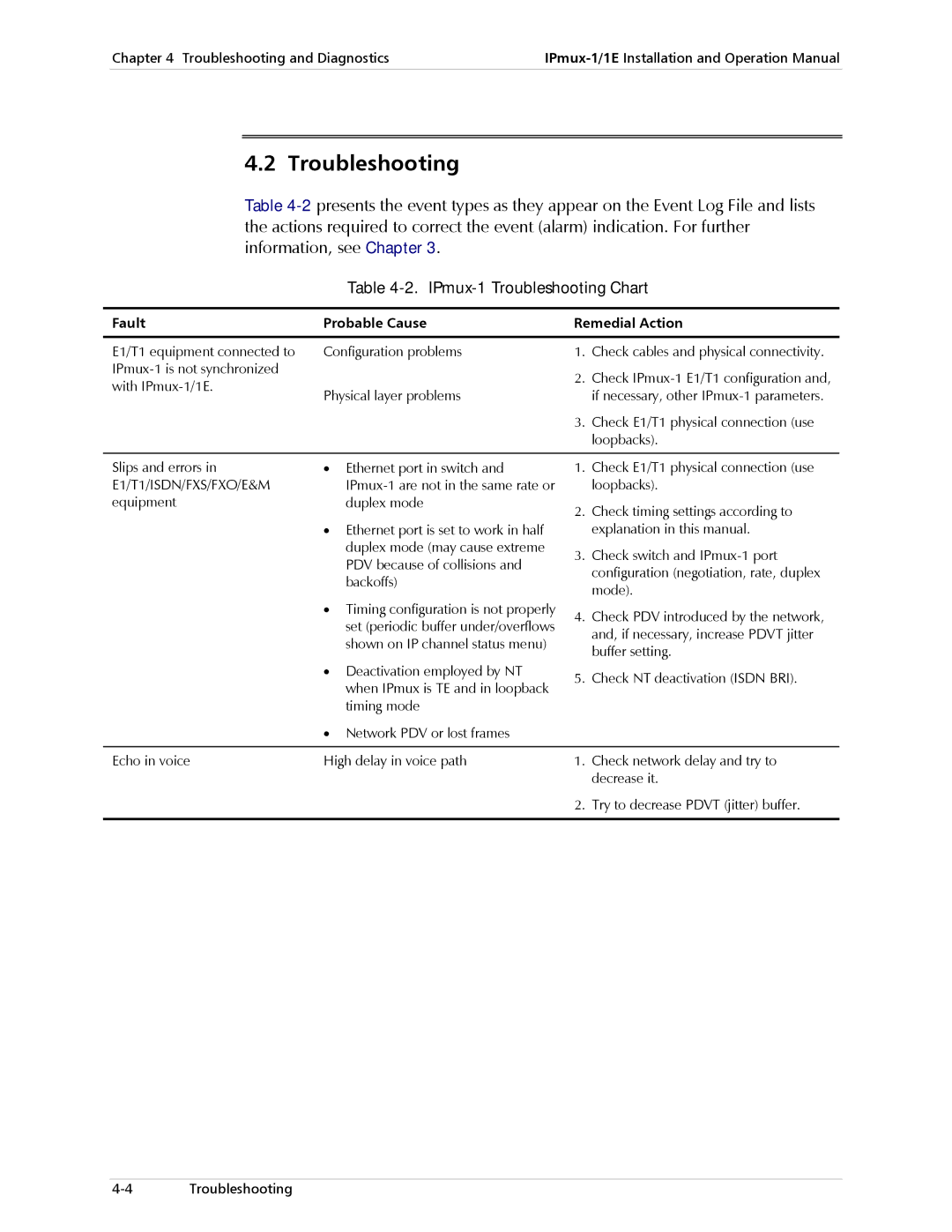IPmux-1, IPmux-1E
Page
International Headquarters RAD Data Communications Inc
IPmux-1, IPmux-1E
Limited Warranty
Please observe the following precautions
General Safety Instructions
Connection of DC Mains
General Safety Practices
Connection of AC Mains
Connection of Data and Telecommunications Cables
Ports Safety Status
Electromagnetic Compatibility EMC
Canadian Emission Requirements
Manufacturers Name Manufacturers Address
Safety
Product Name
Supplementary Information
Manual Organization
Foreword
Conventions
Page
IPmux-1, IPmux-1E
Limited Warranty
General Safety Instructions
Handling Energized Products
Connection of Data and Telecommunications Cables
Electromagnetic Compatibility EMC
Canadian Emission Requirements
Declaration of Conformity
Preface
Conventions
IPmux-1/1E Operation
Setting Jumpers IPmux-1E Isdn Version Only
To set the IPmux-1E ISDN-S module jumpers
To operate the IPmux-1/1E
General
IPmux-1/1E Configuration
Configuration
Contents
Overview of Menu Operations
Troubleshooting and Diagnostics
Iii
List of Tables
IPmux-1 with E1 interface
Overview
Versions
Options
Applications
E1/T1 Circuit Extension over an IP/Ethernet Network
Digital Isdn Application V5.1 Concentration of Remote BRIs
Management
Features
Ethernet Ports
Isdn BRI
There is no user port, the network fiber option is SC
Fiber Options
To calculate Optical Budget
To calculate Distance
Timing
Physical Description
QoS
Rear Panel
Functional Description
Front Panel
Dynamic CAS Mode
Static Mode
CESoIP Mode
Operation Modes
NT Mode
TE Mode
E1/T1
Unframed Transparent
First Channel Second Channel
Timeslot Assignment in a Bundle
Timing Modes
Testing
External Network Timing
Network Timing Schemes
Single Source Clock Network
12. IPmux-1 in External Clock Mode
15. TDMoIP Frame Structure
Frame Format
Layer IP Layer
Layer
Layer Data
Ethernet Frame Structure
UDP Support
Packet Delay Variation
Vlan Support
Intrinsic PDV in Static Mode
Pdvt Buffer Effect on Delay
To configure jitter buffer depth
Pdvt Jitter Buffer
Intrinsic PDV in CESoIP Mode
Intrinsic PDV in Dynamic CAS Mode
Ethernet Throughput in Static Mode
Ethernet Throughput
Unstructured
Ethernet Throughput in Dynamic CAS Mode
Structured
Vlan + frame overhead + payload *
Ethernet Throughput in CESoIP Mode
Round Trip Delay
Frame overhead does not include
Preamble field 7 bytes
Round Trip Delay in Dynamic CAS Mode
Round Trip Delay in Static Mode
Packet Delay in CESoIP Mode
Reorder and Duplication of Ethernet Frames
Duplicated Frames
End-to-End Alarm Generation
OAM Connectivity
Vlan Check for Packets that are Received by IPmux-1/1E
Vlan Traffic Behavior
Vlan Check for Packets that are Sent by IPmux-1/1E
Packet Type Source IP Check Vlan Check
Rate Limiter Option
Internal Switch Operation Modes
Ethernet User Port
Frame Action Switch Action
Switch Behavior
Basic Mode
User Tagged Mode
User Untagged Mode
10. Rate Mode
Rate Mode
11. Rate+User Tagged Mode
Rate + User Tagged Mode
Typically connected to another switch
Rate + User Untagged Mode
Lease Length
12. Rate+User Untagged Mode
Manager Option
Technical Specifications
Optional user port is present
B8ZS, B7ZS, AMI
Compliance 168
Number of Ports
Ms tail support
Line Impedance Balanced 120Ω Unbalanced 75Ω
On port is synchronized no alarm
On power supply is OK
OFF signal loss, LOF or AIS is detected
Local alarm
Power
Introduction
Introduction
Chapter Installation
Site Requirements and Prerequisites
Package Contents
Setting Jumpers
Installation and Setup
Equipment Needed
IPmux-1
IPmux-1E ISDN-S Jumpers
IPmux-1 Front Panel for Two Ethernet Ports
Connecting Interfaces and Cables
Fuses
Grounding
E1/T1 Port Connectors Pinout
Location of Connectors
Ethernet Port Pinout
Pin Designation Direction Function
Control Port Pinout
Pin Number Signal Name
E&M Interface Pin Assignments for RJ-11
Connecting the Control Port
FXS/FXO Interface Pin Assignments for RJ-11
Pin Number Designation Function
AC Power Connection
Connecting the Power
To connect AC power to IPmux-1/1E
Pin Number Signal Name Function
DC Power Connection
Installation Installation and Setup
Chapter Operation
Front Panel Controls, Connectors, and Indicators
Name Type Function
IPmux-1 Front Panel LEDs
IPmux-1E Front Panel Indicators
Turning IPmux-1/1E On
Operating Instructions
Without Control Terminal
With Control Terminal
Turning IPmux-1/1E Off
Login
User Name and Password
Navigating
Getting Started
Overview of Menu Operations
Main Menu
IPmux-1 E1/T1 Terminal Menu Tree
IPmux-1E ISDN-S Terminal Menu Tree
IPmux-1E FXS/FXO/E&M Terminal Menu Tree
Configuration Connection Configuration Connection Mode
Activation Criterion
Main Menu
Connection Mode Configuration Connection Configuration
System Menu
To access the System menu
IPmux-1/1E Main Menu Options
IPmux-1/1E Main Menu
To access the Configuration menu
Setting IPmux-1/1E Configuration Options
Configuration
System
14. IPmux-1E ISDN-S Configuration Menu
Performance Monitoring
Performance Monitoring
To view Performance Statistics
Performance Monitoring
Operation Overview of Menu Operations
Working with the Alarm Buffer
Error Detection
Using Front Panel LEDs
Event Description Corrective Action
Event Types
LOS END
IPmux-1 Troubleshooting Chart
Troubleshooting
E1/T1 Statistics
Performance Monitoring and Troubleshooting Statistics
AIS Febe BES SES UAS Lomf
LOS
LCV
LOS LOF RED LCV
Alarm Description
E1/T1 Alarms
LCV
Febe
SES
One Ethernet Port
LAN Statistics
To view the LAN statistics
Main Menu Æ Performance Monitoring Æ LAN Statistics
Troubleshooting and Diagnostics
Parameter Description
LAN Statistics Parameters
Parameter Description Frames Transmitted
LAN Statistics
With User Ethernet Port
Troubleshooting and Diagnostics
Check the network interface card
Parameter Description Frames Transmitted
Bundle Connection Status
Bundle Connection Statistics
To view the Bundle connection status
Bundle Connection Status Parameters
To Chapter
Synchronous and constant flow
Transmitting them all at once
↓ Internal/External /Disable
Diagnostic Tests
E1/T1
External Loop
Tone Injection
Remote Loopback
To run a loopback test
To run a test
Answer
Frequently Asked Questions
UDP Destination Port
ToS
Answer
Troubleshooting and Diagnostics Frequently Asked Questions
General
Booting IPmux-1/1E
Boot Sequence
To access the file system
Accessing the File System
Exist
Boot Menu
Page
To open a Telnet application
Using Telnet to Manage the IPmux-1/1E
Starting a Telnet Session
To establish a Telnet session
Telnet Operation
System Security
Telnet Access
Appendix B Telnet Using Telnet to Manage the IPmux-1/1E
Snmp Operations
Snmp Environment
Snmp Principles
MIBs Supported by the IPmux-1/1E Snmp Agent
Management Information Base MIB
MIB Structure
Snmp Communities
Management Domains under Snmp
Network Management Stations
Authentication
Figure D-1. Tftp Downloading Procedure
Inband Tftp Download Procedure
Before performing Tftp download
Preliminary Procedure
Log in as Superuser su
Table D-1. Browse MIB Fields
Press Start Query
Checking the Download
To check the download
Figure D-3. System Description
Appendix E Configuration Menus
Main Menu
Configuration
System
Performance Monitoring
General Information
Viewing the IPmux-1/1E System
General Information
Figure E-3. General Information Window Isdn
Self-Test Results
To reset the IPmux-1/1E configuration
Reset
System Event Log
For details
Ping
Logfile Events
To ping
Logfile Events
General Configuration Menu
General Configuration
Ping
Vlan ID
To configure the Host IP address and IP Mask
Default Gateway
To change a configured Host IP
Host IP
Dhcp Status
Management Configuration
Authentication/Community
To access additional manager-list parameters
Table E-3. Authentication/Community Parameters
Manager List
Off
Table E-4. Manager List Parameters
Alarm Traps Mask
Alarm Traps Mask
Table E-6. IPmux-1/1E Alarms
Ascii Terminal Configuration
To configure Telnet Access
Alarm ID Alarm Description Trap Sent to NMS
Download/Upload Using Xmodem
Time/Date Update
Table E-7. Ascii Terminal Configuration Parameters
To Download/Upload using Xmodem
DOWNLOAD/UPLOAD Using Tftp
DOWNLOAD/UPLOAD Using Xmodem
To save the parameters and start the transmission process
Table E-10. Download/Upload Using Tftp Parameters
0.0 to
View Transfer Status
Figure E-21. Reset Default Warning
Set Default Parameters
E1 Configuration
IPmux-1 E1/T1 Configuration
E1 Configuration
Default -10 dB
Default Disable
CRC4 Enable
CRC4 Disable
CAS disable
CAS enable
Default CAS Enable
Default FF
T1 Configuration
T1 Configuration
T1-ESF
B8ZS
Mode will be set by signaling mode field #6 to either
Framer will be configured to T1-ESF mode. Operation
Default T1-ESF
Default B8ZS
Default 7F
Isdn Configuration
IPmux-1E Configuration
Isdn Configuration
Table E-14. Isdn Configuration
Isdn Channel Configuration
Isdn Channel Configuration
Table E-15. Isdn Channel Parameters
Analog Configuration
Analog Configuration
Wiring Wire, 4-Wire Valid only for E&M
Valid only for FXO
Channel Configuration
Analog Channel Configuration
Signaling Profile Configuration
Signaling Profile Configuration
To configure the Connection
Connection Configuration Static Mode
Connection Configuration
ESC
IP TOS
Bundle Connection Configuration Static Mode
Bundle Connection Configuration
To 300 milliseconds
Default 0.0.0.0 not configured
None, Secondary
Primary
Protection Switching Configuration
Protection Switching Configuration
Disable, Immediate Msec to 1 sec
None
Connection Configuration Dynamic CAS Mode
Bundle Connection Configuration Dynamic CAS Mode
24 to
Disable Default Disable
Activation Criterion
Connection Configuration CESoIP Mode
Activation
Criterion
Figure E-37. Connection Configuration
Bundle Connection Configuration CESoIP Mode
To 63 msec
First define the bundle
1796
1796 to
LAN Configuration
LAN Configuration No User Port
100BaseT Full-duplex
Table E-25. LAN Configuration Parameters
DS0 Bundle Configuration
10 DS0 Bundle Configuration
Active Echo Cancellation Timeslots
SET
Compliance to Standards
Performance Monitoring
To save the change
Table E-27. E1/T1 Statistics Parameters
Alarm Failure Comments
Parameter Description
Table E-27. E1/T1 Statistics
Table E-28. Link Status Parameters
Table E-29. Isdn Statistics Parameters
Isdn Statistics in IPmux-1
To view statistics for the next interval
Isdn Statistics
Analog Status
Analog Status IPmux-1E with FXS/FXO/E&M
On hook Off hook Ringing
Table E-30. LAN Status
To reset counters
LAN Status no User port
Frames transmitted to the network
Statistics Values Description Frames received from the user
Bundle Connection Statistics
Bundle Connection Status /Statistics
Parameter Possible Values / Remarks
Table E-31. Bundle Connection Status/Statistics Parameters
Default 120 seconds
Ethernet Configuration/Status with Ethernet User Port
Switch Configuration
Aging Time
Figure E-49. LAN Configuration Two Ethernet Ports
LAN Configuration
Default 100 Mb
Table E-32. LAN Configuration Two Ethernet Ports
This item is displayed only in user tagged, user untagged
Rate+user untagged modes
Vlan Configuration Vlan ID
Vlan Configuration
Erase MAC Table
To erase the MAC Table
LAN Status
Table E-34. Vlan Configuration Rate+User Tagged Mode
Maximum number of allowed entries is
Parameter Values Remarks
To view statistics for next channel
Figure E-53. LAN Status Menu Two Ethernet Ports Internal
Table E-35. LAN Status Two Ethernet Ports
Page
Index
Datagram, 1-16 date, E-13
Configuration menu, 3-14 connection
Jabber, E-57
FXS
Max Capability, E-52 menu tree
QoS
Packet delay
Version, D-3
Timeslot, 1-12, E-40 timing
DC Power Supply Connection Terminal Block Connector
TB Plug with Captive Screws optional
DC Power Supply Wire Voltage Polarity
XMODEM, E-13
Index
Excellent Good Fair Poor Very Poor
Customer Response Form
Page
Error Report
Page
Page
International Headquarters

